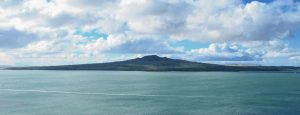
Rangitoto Island is far older and was active much longer than previously thought, a new study has found.
Associate Professor Phil Shane from the University of Auckland’s School of Environment led a team of researchers in a project over summer 2015 to drill up to 150m below the volcano’s surface to investigate its volcanic past.
Sample cores extracted from the drilling were then analysed using radiocarbon dating technology which showed the volcano is around 6000 years old.
“It was generally thought Rangitoto formed in one or two episodes about 500 to 550 years ago and was geologically a very young volcano but the core samples show it began erupting far earlier, around 6000 years ago,” Dr Shane says.
Rangitoto is unusually large compared to other Auckland volcanoes, representing a third to a half of all magma erupted over the entire history of the Auckland region. Dr Shane suspects the volcano may actually be a cluster of a number of small volcanoes beneath one single, large volcanic edifice.
“That suggests the volcano was intermittently active over a much longer period and grew over time rather than forming in one short burst,” he says.
Geologists now wonder if the eruption behaviour of the Auckland volcanic field has changed. Older volcanoes appear to have erupted in short bursts of just months or years, and there is no pattern to where they formed.
The traditional view was that a new volcano would probably form in a location that had not previously experienced an eruption. In contrast, activity at Rangitoto continued for thousands of years, leading scientists to consider whether future activity will also occur in the general area of Rangitoto.
“The latest findings may have implications for hazard and risk planning,” Dr Shane says.
“It’s important to consider that future eruptions could occur at the volcano or if a new volcano forms, it could be active for a very long time such as hundreds or thousands of years.
“That could mean people having to adapt to living with continuing volcanic activity as they do in Hawaii or Iceland.”
The new results are published in the Geological Society of America Bulletin.
Note: The above post is reprinted from materials provided by University of Auckland.









